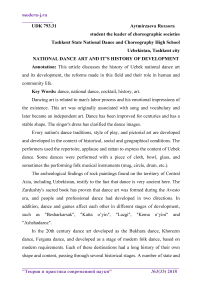National dance art and it's history of development
Автор: Aytmirzaeva R.
Журнал: Теория и практика современной науки @modern-j
Рубрика: Основной раздел
Статья в выпуске: 3 (33), 2018 года.
Бесплатный доступ
This article discusses the history of Uzbek national dance art and its development, the reforms made in this field and their role in human and community life.
Dance, national dance, cocktail, history, art
Короткий адрес: https://sciup.org/140272963
IDR: 140272963
Текст научной статьи National dance art and it's history of development
Dancing art is related to man's labor process and his emotional impressions of the existence. This art was originally associated with song and vocabulary and later became an independent art. Dance has been improved for centuries and has a stable shape. The singer's dress has clarified the dance images.
Every nation's dance traditions, style of play, and pictorial art are developed and developed in the context of historical, social and geographical conditions. The performers used the repertoire, applause and rattan to express the content of Uzbek dance. Some dances were performed with a piece of cloth, bowl, glass, and sometimes the performing folk musical instruments (mug, circle, drum, etc.).
The archeological findings of rock paintings found on the territory of Central Asia, including Uzbekistan, testify to the fact that dance is very ancient here. The Zardushty's sacred book has proven that dance art was formed during the Avesto era, and people and professional dance had developed in two directions. In addition, dance and games affect each other in different stages of development, such as "Besharkarsak", "Katta o’yin", "Lazgi", "Kema o’yini" and "Ashshadaroz".
In the 20th century dance art developed as the Bukhara dance, Khorezm dance, Fergana dance, and developed as a stage of modern folk dance, based on modern requirements. Each of these destinations had a long history of their own shape and content, passing through several historical stages. A number of state and folk dance groups are internationally recognized. Here are some of the most interesting topics in the story: Hamdamxon, Yusufjon Shakarjonov, Usta Olim Komilov, Tamarahonim, Mukarrama Turgunbaeva, Gavhar Rakhimova, Roziya Karimova, Qunduz Mirkarimova, Karim Rahimov, Kadir Muminov, Mamura Ergasheva, Yulduz Ismatova, Shokir Ahmedov, Gavhar Matyakubova, Rushana Sultanova and Dilafruz Jabborova, Dustmukhamedova, Malika Akhmedova, and many other dance masters.
To begin with, in 1932 the republican ballet school named Tamarahonim opened, which began its activity with 30 pupils and directed its activity to training personnel for opera dances. This institution in 1933-41. was called the 1 st Republican Ballet School, and in 1943-47 he was the first in the republic. - The Uzbek State Opera and Ballet Studio. The first director of the school was M.Harratov, the first teachers - Usta Olim Komilov, Tamarahonim, M.Turgunboeva. Over the course of its activity, this new educational institution produced over 70 national artists, geniuses of choreographic art. Among them were G. Izmailov, B. Korieva, H. Komilov, K. Mikrarimov, G. Mavaev, R. Tanguriev, F. Nosirova. In 1947 the school was moved to a specially constructed new building and turned into a choreographic school. Ballerinas G. Khamroev, F.Sadullaev, N.Alimov, Z.Davlatmurodov, who were educated here, raised the Uzbek art of ballet to a new stage of development.
In the 1920s Tamarahonim and other dancers and dancers did not create new dances, they adapted the Uzbek folk dances to the stage. In the 1930s, M.Turgunboeva made a huge contribution to the development of this industry, she began to create her first solo dances. In the 1950s, with the creation of the ensemble "Bahor", the dance turned into a full-fledged stage art. The first professional Uzbek dancer is Tamarahonim.
She first entered the dance scene in1919, and starting in 1922 she began her career as the only dancer in the ensemble of Kory Yokubova. In 1925, in Paris, and then in1935 in London, she widely promoted Uzbek national choreographic art, and along with Usta Olim Komilov, Tamarakhonim was awarded a gold medal of the competition. Another queen of Uzbek professional dance is M.Turgunboeva from Margelan. For the first time she performed on stage in 1929 in Samarkand in 16 years. Yusufzhon Kizik, Usta Olim Komilova, Tamarahonim took the lessons of the scenic art.
During the years of independence a number of good works have been done to develop Uzbek national dance art. The normative documents on the development of the industry have been adopted, and the National Dance and Choreography School has been established. Such practical work is still going on. In particular, in accordance with paragraph 4 of the Decree of the President of the Republic of Uzbekistan of February 15, 2017 "On Measures for Further Improvement of the Management System in the Culture and Sports" of the President of the Republic of Uzbekistan, "Uzbeknavo" variety association and "Uzbekkonsert" state association , and a new department within the institution has been established - the Department of Dancing and Choreography Development and Organization. His goals and objectives, what he would do in the future, were determined.
Today there are 10 state and private dance ensembles in Tashkent. More than 200 dancers and dancers operate in these ensembles. There are 16 dance groups in the Republic of Karakalpakstan and regions, where about 400 artists are working. More than 150 dancers, dancers and ballet artists work at the A.Navoi, Muqimiy, Berdaq musical theaters and the Tashkent operetta theater.
Despite the wide opportunities for the development of the industry, today's dance art is not satisfactory. Recently, in the media, criticisms and criticisms on national dance art have revealed a number of shortcomings and challenges facing today's dance art, as well as the dance style of the region, and the loss of national features of dance art it is not difficult to know why.
Список литературы National dance art and it's history of development
- Avdeeva A. From the history of Uzbek national dance. I book. Tashkent, 2001.
- Baxta I.G., Romanovskaya E. Uzbek dancing. Great game. Archive Institute art by named Xamzy UzSSR. T (B) B-30, No. 247, T (F).
- https://4dancing.ru/blogs/070115/2002/


